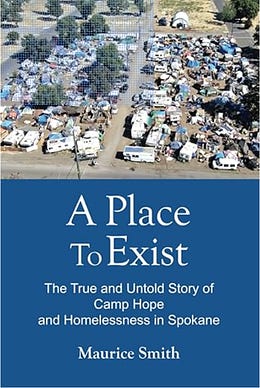A Place to Exist

“A Place To Exist” became available on Amazon books on September 19th. (It is not yet listed online at Auntie’s, unfortunately.) I highly recommend that my readers obtain a copy, read it, share it, discuss it, and take it to heart.
All of us in Spokane who read or watched the news—or drove past or visited Camp Hope while it existed on the block near near Thor and I-90—or listened to the condemnations and legal threats issuing from City of Spokane Mayor Woodward, Chief of Police Meidl or Spokane County Sheriff Ozzie Knezovich—is aware of the controversy surrounding Camp Hope. For months between December of 2021 to its successful closure in June of 2023 Camp Hope was the largest homeless encampment in the State of Washington—and a lightning rod for controversy over increasingly visible homelessness in Spokane and more broadly in the nation.
The author of “A Place to Exist”, Maurice Smith, served tirelessly as one of those who helped manage and bring order to Camp Hope. As a gifted writer and video documentarian of homelessness in our Spokane community, Smith is uniquely positioned to tell the story of the Camp and articulate the lessons we should all take away from it. His book provides a view of those experiencing homelessness that is too little expressed in the media.
As is often the case with books I read, one iconic image from “A Place to Exist” sticks in my mind. By now we have all seen ragged people reduced by circumstances to pushing all their remaining belongings along city streets in a shopping cart, buffeted by exhortations to “move along”. Little had it dawned on me until I read the passage below that the mere possession of a shopping cart, an item so basic to transporting one’s few possessions, could provide the grounds for law enforcement to enmesh such an unfortunate in the endless machinations and entanglements of our legal system. I will never see a person pushing a shopping cart along the street in the same way again.
Painful experience teaches us that, all too often, the interaction between law enforcement and those experiencing homelessness becomes an ongoing game of homeless wack-a-mole, forcing the homeless to move with no effective options while generating new and additional barriers that only complicate their journey out of homelessness. Handing out citations for trespassing, or 3rd degree possession of stolen property (i.e., a shopping cart), or obstructing a sidewalk may send you to Community Court, but the service providers at Community Court don’t have any more services, resources, or housing options available than anyone else does. Using law enforcement as a tool of homeless policy simply isn’t a meaningful solution to homelessness.
In the broad sense, increasing homelessness is a visible manifestation of societal rot we, mostly unwittingly, have brought on ourselves as detailed in Matthew Anderson’s article in RANGE Media that I highlighted in a post last Monday. We must not lose sight of that even as we strive to mitigate the consequences of that rot now expressed in ever increasing numbers of us plunged into poverty and homelessness. “A Place to Exist” goes a long way toward dispelling the stereotypes of the homeless implanted by the endless rhetoric of a political party that fostered the rot and now seeks to demonize the resulting homeless as sub-human, worthy only of being chased away and out of sight.
Keep to the high ground,
Jerry
P.S. Camp Hope was preceded by the Cannon Street Shelter. In many ways one leads directly to the other. The story of the Cannon Street Shelter is masterfully told in a fifty minute documentary video also by Maurice Smith entitled, simply, “The Story of the Cannon Street Warming Center”. Click on the underlined title to watch it on YouTube. It is worth your time.
P.P.S. One last point: The origins of Camp Hope lie in the dismantling of social policies that accelerated with the Republican Party and the Reagan presidency (1980-1988) as detailed in Matthew Anderson’s piece in RANGE Media. The price we now pay in money and in societal strife to try to stem the tide of homelessness that has resulted from that dismantlement is a higher price in time and treasure than we would have paid had we not cast them adrift in the first place.